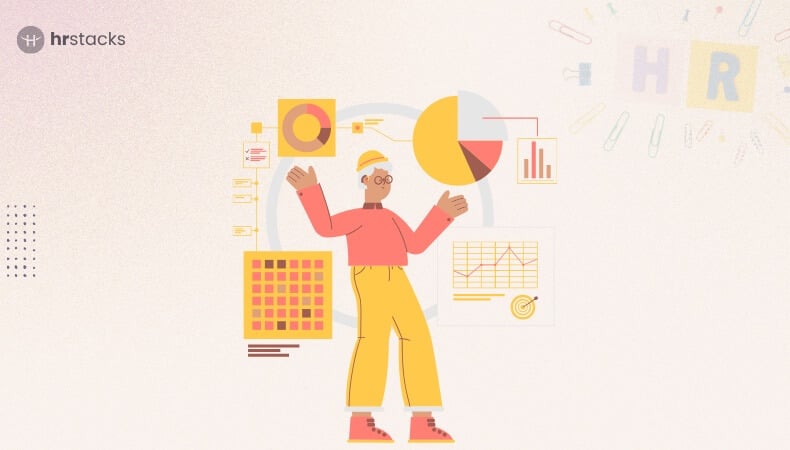From AI-powered recruitment to employee mental health initiatives, HR leaders are navigating unprecedented change.
This article compiles the most important HR statistics for 2025, backed by research, not guesswork. Whether you’re an HR leader, people operations manager, or business strategist, these data points will help you benchmark progress, make informed decisions, and spot trends before they become problems.
We’ve grouped the stats into categories like talent acquisition, DEI, L&D, engagement, compliance, and more, with editorial insights to show you what the numbers really mean.
Key HR Statistics (Editor’s Choice)
- DEI matters more than ever, 56% of employees would take a lower-paying job at a company with a better workplace culture.
- Attracting skilled talent remains a hurdle, with 56% of HR leaders citing it as their top challenge in 2025.
- Remote work is no longer a perk, it’s an expectation. 98% of employees want the option to work remotely at least part of the time.
- Employee referral programs continue to lead, with hires via referrals being 5x faster than those from job boards.
- Burnout is rampant, affecting 79% of employees, with 60% saying it negatively impacts their performance.
- Only 30% of employees feel their feedback is acted upon, highlighting a major trust and transparency gap in performance management.
- HR analytics is proving its value, boosting productivity by 25% and reducing attrition by 50% when used strategically.
- Mental health support influences loyalty, with 73% of employees saying they’d stay longer if their company offered strong mental health benefits.
1. Recruitment & Talent Acquisition
Stat 1: The average cost per hire in the U.S. is $4,700
Insight: Hiring isn’t just expensive, it’s strategic. This figure captures advertising, recruiter fees, onboarding, and ramp-up time. Reducing time-to-hire or improving candidate fit can meaningfully improve ROI.
Source: SHRM, 2025 (SHRM data report)
Stat 2: 70% of job seekers use mobile devices weekly to search for jobs
Insight: Job search has moved to phones. Careers sites, application systems, and employer branding must be mobile-optimized to capture these candidates.
Source: Indeed, 2024 (Indeed labor trends)
Stat 3: Employee referrals are 5× more likely to be hired and stay longer
Insight: Referrals cut time and cost per hire and boost retention. Incentivized referral programs remain one of HR’s most cost-effective sourcing channels.
Source: Jobvite, 2025 (Jobvite annual recruiting study)
Stat 4: Only 36% of companies believe their leadership development strategy is effective
Insight: Despite growing investment, most firms lack measurable success in leadership pipelines. This gap can undermine succession planning and performance.
Source: DDI Global Leadership Survey, 2024
2. Employee Engagement & Retention
Stat 5: 32% of employees are actively engaged at work
Insight: Engagement is alarmingly low; less than one-third of the workforce is emotionally and cognitively invested. Organizations must reinvent engagement strategies to bridge this gap.
Source: Gallup State of the Global Workplace, 2025
Stat 6: 79% of workers feel emotionally disconnected from their work
Insight: Disconnection fuels turnover. Addressing this requires more than perks; it requires meaningful work, strong manager-employee relationships, and clarity of purpose.
Source: Gallup, 2025
Stat 7: 76% of employees say they’d stay at an organization offering clear career growth
Insight: Career progression isn’t optional; it’s a retention lifeline. Clear promotion paths and development plans can significantly reduce attrition
Source: LinkedIn, 2024 Global Talent Trends
Stat 8: 87% of employees believe career progression is vital in retention decisions
Insight: When growth stops, engagement and loyalty often follow. Development must be seamlessly integrated into employee experiences from day one.
Source: PwC Future of Work, 2025

Employee Engagement Trends (2019-2024)
3. Employee Mental Health & Burnout
Stat 9: 81% of HR leaders say burnout is worse than last year
Insight: Burnout continues to climb, not recede. HR must consider long-term strategies, such as workload redesign, manager training, and cultural shifts, to sustainably improve employee well-being.
Source: Sage via PeopleSpheres, citing Gartner 2024–25 findings
Stat 10: 82% of employees are at risk of burnout in 2025
Insight: Burnout is now a near-universal hazard, not an exception. Its detection and prevention should be prioritized like any chronic health threat.
Source: The Interview Guys burn‑out report (aggregating 2024–25 data)
Stat 11: Only 46% of employees feel their company supports mental health well
Insight: Even with growing awareness, fewer than half of employees feel adequately supported. This suggests a disconnect between policy and perceived action.
Source: Modern Health 2024 survey
Stat 12: Companies investing in wellness realize $3–$6 ROI per $1 spent
Insight: Wellness isn’t a cost, it’s an investment. High ROI validates more than just mental health; it boosts productivity and reduces turnover.
Source: Harvard Business Review analysis

Employee Burnout and Mental Health (As of 2025)
4. Remote Work & Hybrid Trends
Stat 13: 92% of employees want at least 1 remote day per week
Insight: Remote flexibility is nearly universal. Organizations ignoring hybrid preferences risk losing talent to flexible competitors.
Source: Owl Labs via Apollo Tech remote-work survey
Stat 14: 75% of employed adults will work from home at least some of the time in 2025
Insight: Remote work is no longer niche; it’s mainstream. This shift demands center-stage focus in policies, tech, and space planning.
Source: Pew Research 2025 study
Stat 15: 87% of remote workers face communication/collaboration challenges
Insight: Flexibility brings friction. Investing in strong remote collaboration tools and norms is essential to keep teams productive and connected.
Source: Owl Labs 2024 report
Global Work Model Snapshot
| Arrangement | % (Global/US) |
|---|---|
| Fully Remote | 12–13% |
| Hybrid | 25–28% |
| Fully In‑Office | 59–61% |
Forbes Advisor

Productivity and Preference Insights on Remote Work
5. Diversity, Equity & Inclusion (DEI)
Stat 16: 76% of job seekers say a company’s DEI commitment influences their job decisions
Insight: DEI isn’t just compliance, it’s strategic positioning. Companies with visible DEI efforts have a competitive edge in talent attraction.
Source: Glassdoor, 2025 Global Workforce Survey
Stat 17: Diverse teams are 36% more profitable than non-diverse ones
Insight: Diversity isn’t tokenistic; it correlates directly with better financial performance, particularly in innovation-centered industries.
Source: McKinsey “Diversity Wins” report, 2024
Stat 18: 79% of executives say inclusive teams drive innovation and future success
Insight: Senior leaders recognize the innovation benefit of inclusive practices, making DEI a key agenda item for strategic planning.
Source: Deloitte Insights, 2024
6. HR Technology & Automation
Stat 19: 75% of companies use HR software for workforce management
Insight: HR tech is now the baseline. From payroll to performance, integrated systems are essential for scalable and informed people operations.
Source: Gartner HR Tech Survey, 2024
Stat 20: 42% of HR teams use AI for recruiting, onboarding, or analytics
Insight: AI is transitioning from theory to application in HR, enhancing speed, personalizing experience, and reducing bias at scale.
Source: SHRM, State of AI in HR Report, 2025
Stat 21: 96% of HR professionals say AI improves talent acquisition and retention
Insight: Near-unanimous confidence in AI proves it’s more than hype, and early adopters report measurable benefits in hiring and retention pipelines.
Source: PwC HR Tech Survey, 2025

HR Tech Adoption Rates by Company Size
7. HR Analytics & Performance Management
Stat 22: Using people analytics yields a 25% productivity boost, 50% lower attrition, and 80% better recruiting
Insight: Data-driven HR isn’t optional; it drives major gains across multiple KPIs from hiring efficiency to workforce stability.
Source: Deloitte “Second Annual State of AI in the Enterprise,” 2024
Stat 23: 70% of employees say traditional performance reviews don’t reflect their work
Insight: Static annual reviews are failing to capture real performance. Continuous feedback models are clearly overdue.
Source: Workhuman Research Institute, 2024
Stat 24: 56% of employees value positive workplace culture over high pay
Insight: Culture now outweighs compensation for job seekers, shifting emphasis from pay banding to environment-building.
Source: Built In Culture Report, 2024
Shift in Performance Management Models Over Time
The data indicates a decline of traditional annual reviews and rise of continuous feedback.
| Year | Annual Reviews | Continuous Feedback |
|---|---|---|
| 2015 | 85% | 15% |
| 2018 | 68% | 32% |
| 2021 | 47% | 53% |
| 2024 | 35% | 65% |
8. Compensation, Benefits & Employee Preferences
Stat 25: 80% of employees would choose better benefits over a pay raise
Insight: Benefits, especially health and wellness, are now primary to employee satisfaction and retention strategies.
Source: MetLife Employee Benefit Trends, 2025

Benefits vs. Pay Preference
Stat 26: 58% of candidates consider benefits a top decision factor
Insight: Benefits shape employer branding. Organizations must clearly and competitively present their total rewards beyond salary.
Source: Robert Half Workplace Survey, 2024
Stat 27: The global gender pay gap remains around 16%
Insight: Persistent inequity highlights the need for action, transparency, audit, and accountable policies are still essential.
Source: World Economic Forum, Global Gender Gap Report 2024
9. Employee Mental Health & Well‑being
Stat 28: 54% of employees are confident their employer cares about their mental health
Insight: Growing awareness isn’t enough; just over half feel supported. Organizations must move from general support to tailored programs embedded in everyday work.
Source: Aflac, 2024 Workplace Mental Health Survey
Stat 29: Workplaces that prioritize mental health see 13% higher productivity
Insight: Mental health isn’t just a wellness checkbox; it boosts productivity and reduces absenteeism. This makes proactive support a business imperative.
Source: Mental Health UK referencing Gallup/PwC, 2025
Stat 30: 73% of employees say they’d stay longer if high-quality mental health benefits were offered
Insight: Mental health benefits aren’t a nice-to-have, they’re retention drivers. Quality matters far more than glossy wellness perks.
Source: Modern Health Research, 2025
Stat 31: Employees using mental health support stay 5.5% longer
Insight: Engagement with mental health programs correlates with real workforce stability. These services earn their keep, and then some.
Source: Modern Health analysis, 2024
10. Learning & Development (L&D)
Stat 32: Companies spend $1,200–$1,500 per employee annually on L&D
Insight: L&D is a strategic investment. This level of spend signals the expectation for measurable return, retention, performance, and growth.
Source: Josh Bersin via 2024–25 industry reports
Stat 33: Only ~10% of people analytics teams operate with enterprise-level rigor
Insight: Despite tech investments, most analytics efforts remain “science projects.” Leading companies treat people’s data with the same discipline as finance or supply chain.
Source: Josh Bersin analysis, 2024
Stat 34: 11% say leadership doesn’t value career development; L&D isn’t blocked, but resourced disjointedly
Insight: Career growth isn’t held back by leadership resistance; it’s blocked by inconsistent execution. L&D needs systems and manager-enablement, not excuses.
Source: LinkedIn Learning Workplace Learning Report, 2025

11. Compliance, Privacy & Risk
Stat 35: Non-compliance fines average $14,000 per violation
Insight: HR isn’t just about people; it’s a guardian of legal and regulatory risk. The financial hit from compliance failures is real and quantifiable.
Source: U.S. Department of Labor, 2024 (via HR research reviews)
Stat 36: 68% of employees worry about workplace data privacy
Insight: Privacy isn’t optional, it’s central to trust in a data-intensive workplace. HR must manage analytics ethically to avoid eroding confidence.
Source: Cisco Privacy Benchmark, 2024
12. Turnover, Absenteeism & Workforce Demographics
Stat 37: U.S. voluntary turnover rate is 47%
Insight: Nearly half of U.S. employees leave each year, indicating persistent challenges in engagement, culture, compensation, or growth. Stemming turnover requires targeted retention strategies.
Source: Bureau of Labor Statistics, 2024
Stat 38: Unscheduled absenteeism costs $3,600/year per hourly worker
Insight: Unexpected absences don’t just disrupt operations; they incur hidden costs from overtime, hiring temps, and lowered morale. Tracking and prevention programs are critical.
Source: Investopedia, 2024
Stat 39: Unscheduled annual absenteeism: $2,650 per salaried employee
Insight: While salaried staff don’t clock out hourly, their absence still carries organizational ripple effects in project delays and redistributed work.
Source: Investopedia, 2024
Stat 40: One in five workers (20%) will be over 55 by 2030
Insight: An aging workforce brings both experience and evolving needs; flexible hours, ergonomic support, and succession planning are essential to harness their value.
Source: AARP Workforce Study, 2025

13. Future of Work & Skills Trends
Stat 41: 85 million roles may be automated by 2025; 97 million new roles could emerge
Insight: The net displacement from AI and automation highlights an urgent need for reskilling and dynamic workforce planning. Leading companies are preparing by investing in human capital.
Source: World Economic Forum Future of Jobs Report, 2024
Stat 42: 72% of companies are embracing skills-based hiring
Insight: Skill-first hiring removes barriers, improves candidate fit, and supports career mobility. This shift aligns talent with capability, not pedigree.

Source: PwC Future of Work Report, 2025
14. Employee Voice, Recognition & Feedback
Stat 43: 30% of employees strongly agree that their feedback is valued
Insight: Only a third feel heard. Without formal feedback systems, companies risk unmet concerns and disengagement. Real-time routing and action matter.
Source: Gallup State of the Global Workplace, 2025
Stat 44: Employee advocacy lifts talent attraction by 58% and retention by 20%
Insight: Cultivating employee champions is more powerful (and credible) than any employer brand campaign. Investing in advocacy amplifies recruitment and loyalty.
Source: LinkedIn Global Talent Trends, 2025
Stat 45: 69% of employees would work harder if better recognized
Insight: Recognition isn’t fluff, it’s performance fuel. Tapping into worker motivation pays direct dividends in productivity and retention.
Source: Workhuman Engagement Report, 2025
15. Hybrid & Remote Work Insights
(Note: Complementing earlier sections, this addresses employee preferences directly.)
Stat 46: 92% of employees want at least one remote day weekly
Insight: Reiterating the near-universal demand for hybrid work, rigid in-office policies risk disengaging the majority of the workforce.
Source: LinkedIn Global Talent Trends, 2025
Stat 47: 85% of employees intend to continue working remotely at least occasionally post‑pandemic
Insight: Remote work isn’t a residual trend; it’s a long-term channel. Organizations need robust virtual collaboration infrastructure and inclusive cultural practices.
Source: McKinsey Future of Work, 2024
16. Skills Gap & Workforce Modeling
Stat 48: 87% of organizations cite skills gaps as a top workforce challenge
Insight: Talent shortages aren’t just about recruiting, they’re about updating skill sets. Strategic workforce planning is now cornerstone to competitiveness.
Source: PwC Future of Work Report, 2025
Stat 49: 60% of employees say they lack skills needed for their future roles
Insight: Employees are self-aware and anxious. That’s an opportunity: development programs that match aspirations with organizational needs deepen loyalty.
Source: LinkedIn Learning Workplace Learning Report, 2025
17. Employee Privacy & Engagement
Stat 50: 68% of employees worry about their workplace data privacy
Insight: Trust is fragile. Without transparent data policies and privacy-first HR tech, analytics programs risk backlash and engagement erosion.
Source: Cisco Security Privacy Benchmark, 2024
Stat 51: 56% of employees prioritize a positive workplace culture over higher pay
Insight: Reinforcing the earlier stat, culture isn’t a soft benefit; it’s a strategic lever. Cultivating inclusion, respect, and belonging pays dividends.
Source: Built In Culture Report, 2024
Final Takeaway
From skyrocketing turnover rates and widening skills gaps to the rapid rise of AI and changing expectations around mental health and flexibility, today’s HR leaders are navigating more complexity than ever before. But with complexity comes opportunity.
These 53 HR statistics aren’t just data points; they’re signposts. They highlight what’s broken, what’s working, and where the profession is headed.
Here’s what smart organizations will do next:
- Double down on retention by offering growth, purpose, and flexibility, not just perks.
- Rethink recruitment using skill-based models, mobile-first channels, and employee advocacy.
- Invest in HR tech and analytics to streamline decisions, but balance automation with empathy.
- Make well-being and DEI foundational, not performative.
- Stay compliant and ethical, especially around data and privacy.
Use this report as your annual benchmark. Share it with your team, incorporate it into your HR strategy deck, and revisit it regularly. We’ll be updating it throughout 2025 as new data comes in.










